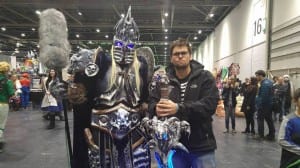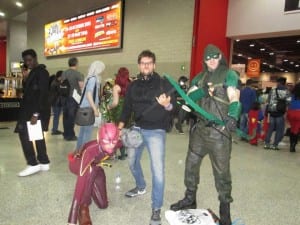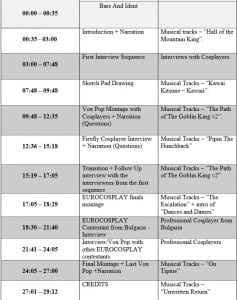During the rest of the post production process communication with the rest of the crew was key. When I was editing the audio for example I noticed small sequences in the video that did not fit the picture and did not flow correctly with the audio. I quickly made sure that my team knew about that and made notes and markers on my session just to make sure that it will be fixed.
They reacted rapidly as they were also in the process of editing the video. I received the initial sound lock on the 23rd of November 2015 and the corrected one on the 27th of November 2015 and provided a complete audio package on the 7th of December 2015. I put in extra time in the studio just so there is sufficient time to correct any mistakes after we’ve all seen and hear the documentary, or if the director and the rest of the crew wanted something to be changed – submitting/completing my work early was a suggestion from Bryan Rudd who gave us a guest lecture/project case study earlier in the semester which was in relation to Proper Project Management. LO1 + LO5 + LO6
Research
POST-PRODUCTION PREPARATION & VOICE – OVER
Before receiving a full sound lock clip I started working on the audio clips just to tidy them up. The first step was to listen through all the recorded audio and to label all the clips so it makes my job easier later in the post-production process.
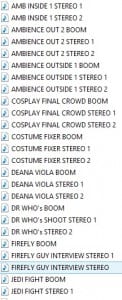 I also frequently asked for separate clips that were already finished so I can see what needs to be done to that audio clip before hand – this helped with my preparation for the post production process ( I synced 2 to 3 interview sequences and played them to my friends and tutor to receive instant feedback LO6).
I also frequently asked for separate clips that were already finished so I can see what needs to be done to that audio clip before hand – this helped with my preparation for the post production process ( I synced 2 to 3 interview sequences and played them to my friends and tutor to receive instant feedback LO6).
In the mean time I also spoke with the Director asking about other documentary productions that she likes the sound of (By suggestion from Lee Gretton who uses the same technique when working on productions for the industry). This way I can have a clear idea of what the director wants from me and I can also use her examples as reference when editing and mixing. We also spoke about the music selection for the feature and decided to go with an overall Epic/Heroic/Magical Feel. I then searched for such musical compositions online and shared my findings with the Director – once we agreed on the tracks we gave them to the editor of the Documentary so that she could edit the montage sequences to the rhythm of the music. All of the tracks are licensed by the Creative Commons (MUSIC LICENCES) and are absolutely free to use as long as they receive a credit at the end of the production. LO1 + LO2 + LO3
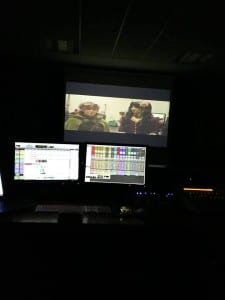
Furthermore I suggested we find a narrator for the documentary as there were a lot of sequences that required voice overs and quite a bit of interview footage that needed someone to ask questions. The voice over was provided by Daniel Berry who is another level 3 Audio Production student I had worked with in other film productions. He has a very deep Narrator type voice and is also a Radio presenter with quite a bit of experience in the field. The Director agreed with my choice and gave me another reference point for the narration.
MCM Comic Con London – 24-25.10.2015 – Location Recordings
Before Recording at a bigger and noisier location I did some research. The crew asked me what equipment I will be bringing to the location and I gave them a list informed by several sources.
In an article named “Sound & Sync” in Sound on Sound magazine J G Harding talks about location recordings, equipment and some post production tips. He suggests that taking a separate portable recorder with a hand-held or boom mic produces much higher quality audio rather than recording sound on camera.
Your camera’s on-board mic might be OK for home movies, but using a separate mic and audio recorder will yield much better results
David Mellor LO1 + LO2
That is why I also decided to record the sound separately.
As good examples of location recording kit he gives The Edirol R44 – a high‑quality four‑track portable recorder, with four mic pre-amps and an on‑board mixer in combination with a standard boom mic like a Rhode NTG2 or a Sony ECM CG50.
The equipment I decided to go with was the Sound Devices 633 portable recorder + the Sennheiser MKH416 Rifle Mic with a cradle and wind jammer (covered with a “dead cat” or an extra wind jamming cover). The reason why I went with that choice is that they were available from our media stores and also Location Sound Recordist Grant Bridgeman recommended this equipment during several guest lectures and workshops.
LO1 + LO2
By suggestions from Lee Gretton – Recording/Mixing/Editing Engineer – I also brought along a separate Zoom H4n Portable recorder with a Clip mic so I can record the interviewer who was asking the questions for each vox pop sequence.
The Headphones I used were the AKG K99 Perception series. LO1 + LO2
All location recordings went really well, the only issues were that there was an airport nearby and there was extensive crowd noises as it was a pretty big event but we dealt with those issues accordingly – kindly asking interviewees to re-record necessary parts of the interviews for continuity sake.
“Some filming situations can feel a little overwhelming – but you still need to be in control. Don’t be afraid to ask your contributor or presenter to do things again if they can, especially to help you get a nice close-up of that object they are discussing” (Bailey,2015).
I ended up with very good location recordings but the only problem was that the clip mic I put on the interviewer couldn’t handle the windy weather and the noise to dialogue ratio was unfortunately in favor of the noise so the audio was unusable. The solution is a voice-over artist in post production. LO4 + LO5
TIMECODE
Dialogue edits and Professional assistance!
When editing the dialogue for the documentary I asked industry professionals that were available to have a listen to the work in progress so that I have a clear idea of what I need to change and what I’m doing right. I was very lucky that at the time Location Sound Recordist Grant Bridgeman was at the University of Lincoln giving guest lectures and workshops to the level 2 Audio Production Students and I met him in the Sound Theater during his preparation for a workshop. He Listened to my edits and audio and gave me specific tips on how to improve some of the clips –
As most of the location recordings were made in a live environment the main issue was that there was a constant crowd noise and low end rumble – Grant Suggested that I make a harsh 100Hz Cut with a noise reduction plug-in or EQ which would sort it out. He also told me to be careful with the lower frequencies of the music tracks as the room had a bass trap and could be quite tricky.
Most of the dialogue in general had that low/low-mid rumble due to the crowd noises so I made harsh cuts at 100Hz like Grant Suggested and slight dips in the lower and higher mids which sorted out the problem.
The audio clips have been checker-boarded for easier edits and for the achievement of better fades/transitions.
All of the dialogue tracks run separately and are rooted to individual SUB faders for each sequence which send the sygnal to a Dialogue Master Fader – I did the same for the musical tracks. The musical level automations throughout the documentary I did using the touch/latch option in pro-tools which involves manual fader operation. This gives me more control over the levels and a more natural feel for the flow of the music – this way I can quickly react to what is happening on screen and adjust the levels to my preference instantly. This technique was shown to me by Chris Hainstock when I asked him to give me feedback on my work in progress.
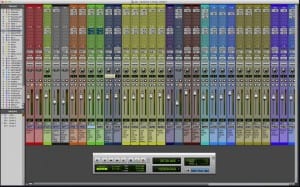
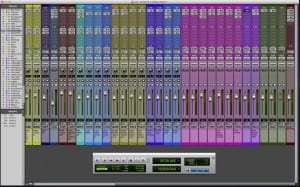
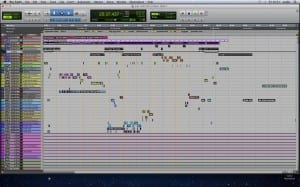
These are techniques that were taught to all Audio Production Students throughout levels 1 to 3 of our course by professionals such as Grant Bridgeman, Chris Hainstock , David McSherry etc. I have also used these techniques in previous projects and have achieved good results with great feedback.
Phil Stephens – Documentary and Film Producer, Chris Hainstock – Sound Editor with extensive experience within the industry also had a listen to the audio at a different stage of the post-production. They noticed some issues with the sync. of the audio and also some inconsistencies with the dialogue levels in a couple of scenes. After a few quick edits and changes they listened to it again and approved.
Having others (especially industry professionals) listening to my work while it’s till in progress helps me determine whether I’m going in the right direction and how I can improve the quality of the production – LO4 + LO6
